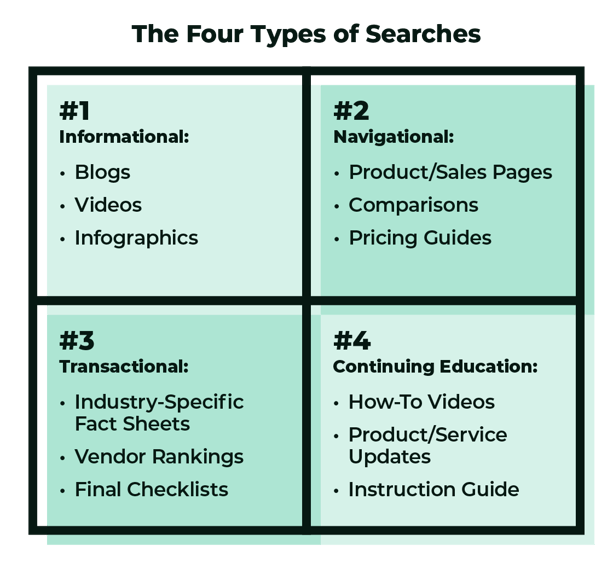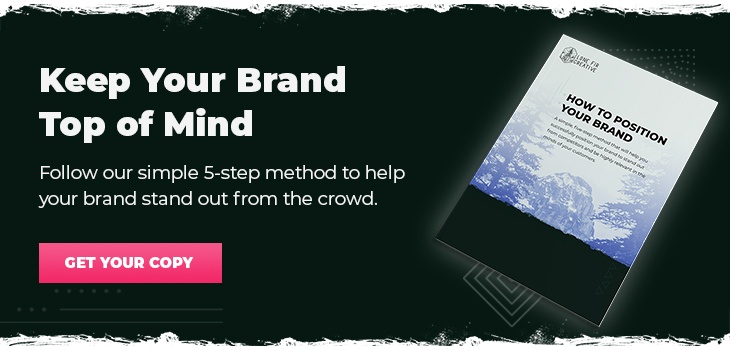Those of you who tuned in last week learned a whole lot about the customer journey. We discussed what it is, what makes it effective and even gave you a tool to build your own customer journey map. This week, we’re building on those same principles and teaching you how to hone your content marketing efforts to fill the gaps in your pipeline.
The most important consideration in this process is search intent. Search intent tells you what information a user is looking for when they type a keyword into the Google search bar. It’s one of Google’s top ranking factors and shouldn’t be ignored in your content marketing.
I’ll walk you through the three types of search you’ve probably heard of before and one that we’re submitting to the Google authorities for consideration. So I’ll also show you how each of these search types correlates with a different customer journey stage and what types of content you need to match the search intent.
A Quick Reminder…
For anyone who didn’t read our customer journey blog, I highly recommend you check it out. Not only will you get some stellar insights from Linda Quezada, it also introduces ideas and foundations that I’ll be building on in this article.
If you did read it, bravo! Here’s a quick refresher before we dive in:
- The customer journey is a series of steps someone takes with your brand both pre- and post-purchase.
- There are five stages in the customer journey: awareness, consideration, decision, retention and advocacy.
- In each stage, people have different thoughts and feelings and need different types of information to keep them in your pipeline or happy with your partnership.
- It is your job to provide that information and act as the educator throughout their journey with your brand.
We covered some other riveting information about lead generation and conversion, but right now, we’ll keep our focus on content.
Search Intent and the Customer Journey
Searching is a unique process. You know exactly which results you need, but you only want to type in a few words to find them. Your customer is the same way, which makes it difficult to assess their search intent based solely on the keywords they’re using, even if you have search engine results page (SERP) data to back it up.
Using your customer journey helps you identify the topics and types of information your customers need in any given stage and match keywords to those search intents. This allows you to plan for search engine optimization (SEO) while catering to exactly what prospects and customers (instead of just the Google gods) want from your brand.
Almost every organization agrees that there are three different types of search queries:
We’ll look at each of these in turn, with a bonus category at the end. I call this fourth type of search “Continuing Education.” It’s rarely addressed or named because most SEO experts are matching searches with the buyer’s journey, which stops when someone becomes a customer. However, just because someone is a customer doesn’t mean they suddenly stop looking for information.
If you’re truly focused on catering to the entire customer journey, then continuing education content is an integral part of your content strategy.

#1: Informational Searches
This type of search is pretty straightforward: People want information. Most of your content will likely live in this wheelhouse because it’s where you can capture the most people.
Typically people at the beginning of their customer journey — awareness stage — are the ones typing in informational search queries. They’re still fleshing out their problem, discovering potential solutions and gathering resources so they can make an informed decision about what step to take next.
We recommend focusing more on long-tail keywords to match this type of search for two reasons:
- They’re typically less competitive and easier to rank for.
- They tend to be more specific, giving you a better idea of what information the user is actually looking for.
Take the below keywords for example. “Lawn mower” is a great punchy keyword, but it’s sitting pretty high on the difficulty chart, which tops out at 100.
Plus, what are those users actually searching for? Do they want to buy a lawn mower, find lawn mower reviews, or choose between gas or electric? You can’t really tell; even the search results are somewhat scattered. (See below.)
“How to fix my lawn mower,” on the other hand, is much easier to rank for and has a clear intention. Someone has a broken lawn mower and they need to know how to fix it.
I know some of you are looking at the search volume column and thinking, “But Leah, that long-tail keyword has a fraction of the searches as 'lawn mower.'” You’re right. But let me pose this question to you: Would you rather write for a difficult keyword that you’re unlikely to rank for and get zero traffic or write to a keyword that you’re likely to rank for and get a little highly qualified traffic?
My advice is to prioritize choosing your keywords as follows:
- Search intent
- Difficulty
- Search volume
But anyway, I digress. Sticking with those long-tail keywords helps you know exactly what information users are searching for so you can tailor your content to match their search intent and their position in the customer journey.
Types of Content
- Blogs – focus on value and information, not selling your products/services
- Videos – explainers with visual aids or demos on-screen
- Infographics – any kind of flow chart, graphic or visual representation that you can support with text
#2: Navigational Searches
Navigational searches represent people looking for you specifically. They’ve usually had some previous interaction with your brand and now they’re ready to learn more and decide if you’re the right fit for them.
If you search the web for advice about navigational search queries, you’ll find a lot of respectable websites basically telling you, “Don’t worry about it. It’s really hard to rank for organically.” And from a strictly SEO standpoint, they’re right.
However, you do have to take into account the times when you are the website people are searching for. This means you have a potential customer firmly in the consideration stage and looking for information about your brand specifically. It’s a golden opportunity to position yourself as an educator.
Navigational keywords are often what we call branded keywords — they include your brand name in the search term or phrase. These are helpful to track because they indicate that people already know your brand and are interested in your products or services.
Although there is less opportunity for optimizing organic search, there’s still a demonstrated need to populate this space with helpful content. So it’s not as much about keyword optimization as it is about meeting people’s needs on the right channels at this point in their customer journey.
Check your website’s keyword rankings and pull out some of the navigational keywords that your brand owns. You can use these as a Litmus test for your site’s content to ensure you have some pieces that address people’s search intent.
For example, you might see keywords like “Mike’s lawn mowers pricing” or “Mike’s lawn mowers riding mowers.” This shows that people considering your brand want more information about your products and pricing. So give them that information, both on your web pages and your content.
You can even go one step further and create comparison guides or a “best of” blog that includes the names of some of your competitors. If done well, you’ll be seen as a trustworthy source and likely pop up in navigational searches for those other businesses.
The overall idea is to combine navigational search queries with customer needs in the consideration stage to ensure you have the information people need and that it’s easy to find.
Types of Content
- Product and sales pages
- Comparison guides
- Pricing guides
#3: Transactional Searches
You’re probably thinking, “Oh yeah! Here comes the money!” However, I urge you to curb your enthusiasm for just a moment.
Yes, transactional search queries typically indicate people in the decision stage who are (almost) ready to buy. But remember, that doesn’t mean they’re ready to buy from you. Harsh, I know, but true.
Not all transactional searches will be leads that you’re already nurturing. In fact, most of them won’t be. Most of these searchers will be new to your brand and only think they’re ready to buy. Once they find the wealth of information they have to consider, they might go all the way back to square one.
The key to nailing content for the transactional search intent is to remember that you’re a teacher to the very end. Even if someone is ready to buy, they still need that little nudge to push them over the edge. They want you to finish convincing them, to reinforce that they’ve made the right decision. That’s why you can’t rely solely on your sales or product pages to capture these users.
You need to create content that caters to the decision-stage leads in your pipeline. This gives those people the last bit of encouragement they need to convert to a customer, and organic viewers can see that you really know your stuff and they need to do some more homework.
Tip: Link some of your top-of-funnel content in these decision-stage pages. That way if someone stumbles on it and is interested, they can easily backtrack and catch up on all the information they need to make a purchase decision.
Types of Content
- Industry-specific fact sheets
- Vendor comparisons or rankings
- Final checklists — this allows readers to qualify themselves and determine if the service/product is right for them
#4: Continuing Education Searches
Transactional searches are pretty much where the internet stops. Three types of search intent, that’s it. But this seems like a disservice to all you readers because people don’t stop searching for information after they become your customer. They still have needs and it’s still your job to meet them.
Introducing the fourth search type: continuing education searches. This search intent is brought to us by your post-purchase journey stages, retention and advocacy, and encompass all those people who are already your customer.
The exact scenario will vary based on your business and customer base, but that’s why you have the customer journey map. It will show you what information people need and want after they become your customer. Usually, this looks like tutorials on how to use your products or access your services, troubleshooting guides and other self-service content.
Focus on long-tail, branded keywords. Things like “how to start Mike’s mowers riding mower” or “Mike’s mowers online customer chat.” For the most part, these search terms will be pretty specific because people are already part of your business and know exactly what information will solve their problem.
I want to note here, that like navigational searches, you aren’t driving significant traffic on this freeway. Don’t get bogged down in finding keywords with a high search volume. You want to focus on providing helpful information for the few who need it and making it easy to find.
The goal of continuing education content is to provide information that helps your current customer get the most out of your relationship. It’s how you can provide continued support and reinforce that they made the right decision partnering with your business.
Types of Content
- How-to videos
- Product/service updates via email or on your blog
- Step-by-step instruction guides
Create Content Customers Need
Most people think of search intent as just a part of an SEO content strategy, but it goes much deeper than that. Pairing a keyword’s search intent with where that user is in their customer journey creates some seriously powerful content that will rank well and encourage leads to stay in your pipeline.
I could talk about content strategy for days, and I have in our blog. So if you’re interested in learning more about building effective content, check out our blog about the Key Elements of Every Effective Content Optimization Strategy.







